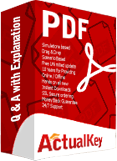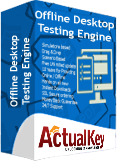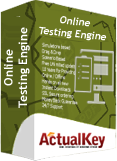Actualkey Prepration Latest APMG-International-AgilePM-Practitioner : Agile Project Management (AgilePM) Practitioner Exam Questions and Answers PDF's, Verified Answers via Experts - Pass Your Exam For Sure and instant Downloads - "Money Back Guarantee".
| Vendor | APMG |
| Certification | APMG Change Management Certifications |
| Exam Code | APMG-International-AgilePM-Practitioner |
| Title | Agile Project Management (AgilePM) Practitioner Exam |
| No Of Questions | 78 |
| Last Updated | June 22,2024 |
| Product Type | Q & A with Explanation |
| Bundel Pack Included | PDF + Offline / Andriod Testing Engine and Simulator |




APMG-International Agile Project Management (AgilePM) Practitioner Exam
Prepare for your exam. Find sample questions, answers and study tips for your Agile Project Management exam below.
Certification in Agile Project Management has become increasingly important for professionals in this field. Recognised certifications like APMG’s Agile Project Management Certification provide a structured framework for people to validate their knowledge and skills in Agile practices and principles. They demonstrate a commitment to excellence and a deep understanding of Agile methodologies, making certified practitioners more valuable assets to organisations.
Using our official sample exam, ensures you are using a reliable and up to date resource in your examination preparation.
Agile Project Management Exam Overview
APMG Agile Project Management (AgilePM) offers two distinct qualification levels: Foundation and Practitioner, each serving a specific purpose. The Foundation qualification assesses candidates' knowledge and comprehension of AgilePM's fundamental principles, ensuring they can identify and distinguish its key components. This qualification acts as a prerequisite for the Practitioner level.
Targeted at both practising project managers and Agile team members aspiring to become Agile Project Managers, a successful Foundation candidate should grasp the underpinning philosophy and principles of Agile methodologies, understand Agile project lifecycles, recognise Agile products and their purposes, comprehend Agile techniques and their advantages and limitations, and be familiar with the roles and responsibilities within Agile projects.
The Practitioner qualification, on the other hand, evaluates whether candidates possess the knowledge and understanding of AgilePM to apply and customise it effectively in real-world scenarios. To be eligible for this level, candidates must hold either an AgilePM Foundation certificate, a DSDM Foundation certificate, or a DSDM Advanced Practitioner certificate.
Like the Foundation qualification, it is aimed at practising project managers and Agile team members aspiring to transition into Agile Project Managers. Successful Practitioner candidates should demonstrate their ability to apply Agile philosophy and principles in project situations, configure Agile project lifecycles accordingly, produce and assess Agile project products, apply various Agile techniques, identify appropriate techniques for specific scenarios, understand Agile project control mechanisms, outline testing and measurement in Agile projects, and manage requirements in an Agile context.
This qualification focuses more on tracking profit for projects, communicating with stakeholders, conflict resolution, communication, and analysis of specific situations, allowing for more detailed, practical application.
Exam Styles and Structures
The AgilePM Foundation exam comprises multiple-choice questions with 50 questions per paper, and candidates need to secure 25 marks (50%) out of the available 50 to pass. The exam is closed-book and candidates are allowed 40 minutes to complete it.
On the other hand, the AgilePM Practitioner exam is an objective examination featuring four questions, each worth 20 points, requiring a total of 40 out of 80 points (50%) to pass. This exam allows open-book access, but candidates are limited to using only the official AgilePM Handbook. A longer duration of 2.5 hours is allowed, providing candidates with the opportunity to apply their Agile knowledge to complex scenarios.
Practice Questions: Agile Project Management Practitioner
Unlike the Foundation exam, this exam is scenario-based and each exam includes 4 questions. You will need to answer questions based on practical scenarios, for example a fictional project and how it uses time boxes could be described. This official sample exam provides detailed examples of both the scenarios and questions you will face during this examination.
Embarking on the path of continuous learning and professional development is not just a commitment to yourself but also an investment in your business needs. Taking your project management qualification seriously can open doors to new opportunities, increased communication, and enhanced leadership abilities.
To help you along this rewarding journey, we've compiled a list of study tips.
Register for an agile project management training course with an approved trainer.
Create a study schedule to manage your time effectively.
Use the official Agile PM study guide and textbook
Use mock exams and sample questions to gauge your readiness.
Join online forums or discussion groups to connect with fellow aspirants and seek advice.
Review case studies and real-world project examples to apply theory to practice.
Seek guidance from an experienced project manager or mentors in your network.
Stay updated with the latest industry trends and best practices through blogs, podcasts, and webinars.
Often, a lack of motivation can make studying challenging. Book your training course or exam via our online portal to give yourself a firm deadline and help make studying a top priority.
Sample Question and Answers
QUESTION 1
Using the Project Scenario and the additional information provided for
this question in the Scenario Booklet, answer the following questions about Feasibility.
Remember to limit your answers to the number of selections requested in each question.
Which 2 statements describe the appropriate application of Agile Project
Management when developing the Feasibility Assessment?
A. The new Project Manager should NOT be involved in finalising the Feasibility Assessment.
B. The Architecture Angels' Finance Director should approve the final Business Case as part of the Feasibility Assessment.
C. The Earth Excavations' Head Gardener should contribute to the outline solutions considered for the gardens.
D. The different options should be presented to the 'Hoy for Hoy Hall' Action Group for their feedback before the chosen outline solution is finalised.
E. The Timber Tigers' Site Manager should be the sole approver of the finalised Feasibility Assessment before development commences.
Answer: BD
Explanation:
In Agile Project Management, it's important to involve key stakeholders and to ensure that there's a
collaborative approach to project decisions. Considering the Agile principles and the given scenario,
the appropriate application of Agile to the Feasibility Assessment would likely involve the following statements:
B . The Architecture Angels' Finance Director should approve the final Business Case as part of the
Feasibility Assessment. In Agile, it's crucial to ensure that the business aspect of any project aligns
with the financial feasibility. The Finance Director's approval would be significant in validating the
economic viability of the project.
D . The different options should be presented to the 'Hoy for Hoy Hall' Action Group for their
feedback before the chosen outline solution is finalised. Agile encourages stakeholder engagement
and iterative feedback. Presenting options to the action group aligns with the Agile value of
customer collaboration over contract negotiation, allowing for community input that could be vital
due to the building's heritage status and the community's interest.
QUESTION 2
Using the Project Scenario and the additional information provided for
this question in the Scenario Booklet, answer the following questions about Feasibility.
Remember to limit your answers to the number of selections requested in each question.
Which 2 statements describe the appropriate application of Agile Project Management when
producing an Outline Business Case to support the Feasibility Assessment?
A. The Feasibility Assessment should contain a detailed description of costs and benefits associated with the refurbishment.
B. Enough description of the required refurbishment work should be provided to enable the Architecture Angels' Finance Director to decide whether the project should proceed.
C. During Feasibility, potential beneficiaries of the project should be involved when the Outline Business Case for the refurbishment is created.
D. The Outline Business Case should demonstrate the mitigation of all business risks associated with the refurbishment.
E. The Outline Business Case should describe the full team structures to be engaged for the later phases of the project.
Answer: BC
Explanation:
In applying Agile Project Management to the creation of an Outline Business Case in support of the
Feasibility Assessment, the following two statements are most appropriate:
B . Enough description of the required refurbishment work should be provided to enable the
Architecture Angels' Finance Director to decide whether the project should proceed.
Agile approaches favor providing just enough detail to make informed decisions without going into
unnecessary depth at early stages. This allows for flexibility and adaptation as more information
becomes available.
C . During Feasibility, potential beneficiaries of the project should be involved when the Outline
Business Case for the refurbishment is created.
Agile methodologies emphasize stakeholder engagement and user involvement early and
throughout the project. This ensures that the project delivers value and meets the needs of those it is intended to benefit.
QUESTION 3
Using the Project Scenario and the additional information provided for
this question in the Scenario Booklet, answer the following questions about Feasibility.
Remember to limit your answers to the number of selections requested in each question.
Which 2 statements describe the appropriate application of Agile Project
Management when developing the Delivery Plan?
A. The Project Manager should include any known constraints associated with planning permission.
B. The Project Manager should NOT need to identify any risks this early in the project.
C. The approach to the project should be based on the Project Approach Questionnaire responses.
D. The Earth Excavations' Head Gardener should be excluded from discussions related to deliverables since contracts are NOT yet signed.
E. The Architecture Angels' Marketing Director should be involved in the development of the Delivery Plan.
Answer: AE
Explanation:
In the context of Agile Project Management, when developing the Delivery Plan during the
Feasibility phase, the two statements that best align with Agile principles are:
A . The Project Manager should include any known constraints associated with planning permission.
E . The Architecture Angels' Marketing Director should be involved in the development of the
Delivery Plan.
Here's the rationale:
A: Recognizing and accounting for known constraints such as planning permission is a key
aspect of Agile. It allows for better adaptability and planning around these constraints. Including
them early in the Delivery Plan helps ensure that they are considered throughout the project.
E: Agile emphasizes cross-functional collaboration and stakeholder engagement. The
Marketing Director would provide valuable insights into customer needs and market conditions,
which are crucial for a successful delivery plan.
QUESTION 4
Using the Project Scenario and the additional information provided for this question in the Scenario
Booklet, answer the following questions about Feasibility.
Remember to limit your answers to the number of selections requested in each question.
Which 2 statements describe the appropriate application of Agile Project Management when
developing the Solution Architecture Definition (SAD)?
A. Paper-based drawings are to be used for each option being considered for the building and gardens.
B. The SAD must include a physically-built miniature model of the Hoy Hall building.
C. The Architecture Angels' Marketing Director can request a SAD to illustrate the achievability of complex elements of the solution.
D. The views of the 'Hoy for Hoy Hall' Action Group members are NOT relevant to the business decision made by Architecture Angels' Finance Director when approving the final option.
E. The SAD should contain high-level costs for all elements of each solution option.
Answer: AC
Explanation:
In the context of Agile Project Management when developing the Solution Architecture Definition
(SAD), the two statements that are appropriate are:
A . Paper-based drawings are to be used for each option being considered for the building and gardens.
C . The Architecture Angels' Marketing Director can request a SAD to illustrate the achievability of complex elements of the solution.
Here's the rationale:
A: Agile methodologies support the use of simple and understandable tools that can quickly
convey ideas and be easily changed. Paper-based drawings align with this by providing a flexible and
adaptable way to represent different options, which can be rapidly modified in response to feedback.
C: It is important for the Marketing Director, who understands the market and customer
needs, to request clarification on complex elements to ensure that the proposed solutions are
feasible and aligned with customer expectations. This contributes to creating a solution that is viable
both technically and from a business perspective.
QUESTION 5
Which 2 statements describe the appropriate application of Agile Project Management when developing the Prioritised Requirements List during Feasibility?
A. Details of which areas will require seeding in order to become lawn, and which are to become planted borders, should be captured.
B. The re-laying of the driveway and a landscaping solution should be listed as Must Have requirements.
C. The scope of the project should be agreed before moving into the Foundations phase.
D. The responsibility for setting the priority of each of the requirements identified should be assigned to the Project Manager.
E. Regulatory obligations associated with the redevelopment of Hoy Hall should be recorded as Must Have requirements.
Answer: BE
Explanation:
In the context of Agile Project Management when developing the Prioritised Requirements List
during Feasibility, the two statements that align with Agile principles are:
B . The re-laying of the driveway and a landscaping solution should be listed as Must Have requirements.
E. Regulatory obligations associated with the redevelopment of Hoy Hall should be recorded as Must Have requirements.
Here's the rationale:
B: In Agile, requirements are often categorized by priority such as "Must Have", "Should
Have", "Could Have", and "Won't Have for now" (the MoSCoW method). The re-laying of the
driveway and a landscaping solution are essential for the project's success and thus should be
classified as "Must Have".
E: Regulatory requirements are non-negotiable constraints that the project must adhere to.
These should always be prioritized in the requirements list to ensure compliance and to avoid legal
issues, making them "Must Have" items as well.
QUESTION 6
HOTSPOT
Using the Project Scenario answer the following question about the technical quality of the solution
to be delivered. An assessment of the maintenance requirement for the new reservation system was
made during Feasibility.
Column 1 describes a list of different types of hotel reservation systems considered. Column 2 lists
the three DSDM maintainability objectives. For each description in Column 1, select from Column 2
the maintainability objective it would support.
Each selection from Column 2 can be used once, more than once or not at all.
Column 1:
1. Off-the-shelf software with ready-to-use templates that will need to be customised to fully meet Hoy Hall requirements, after deployment.
2. Developing a fully functioning in-house system, developed and hosted by Architecture Angels IT Operations team.
3. All-in-one web-based reservation and accommodation management system built to Hoy Hall's specification.
4. All bookings for Hoy Hall to be scheduled by one of the other two hotels within the group, until a suitable system can be implemented at the site.
5. A spreadsheet is used to capture customer details manually. Data will then be exported into a fully functional system at a later date.
Column 2
Maintainability is a required attribute of the initial delivered solution
Deliver first, re-engineer later
Short-term, tactical solution
Answer:
Explanation:
For each of the descriptions in Column 1, the maintainability objective from Column 2 that each
would support is as follows:
Off-the-shelf software with ready-to-use templates that will need to be customised to fully meet Hoy
Hall requirements, after deployment.
A . Maintainability is a required attribute of the initial delivered solution
Rationale: Customizing off-the-shelf software indicates a need for the solution to be maintainable
from the onset to allow for these adjustments.
Developing a fully functioning in-house system, developed and hosted by Architecture Angels IT
Operations team.
A . Maintainability is a required attribute of the initial delivered solution
Rationale: In-house developed systems need to be maintainable to facilitate future changes and
enhancements by the team that created them.
All-in-one web-based reservation and accommodation management system built to Hoy Hall's specification.
A . Maintainability is a required attribute of the initial delivered solution
Rationale: A system built to specific requirements will require the ability to maintain and adjust the
system as needs evolve, making maintainability a key initial attribute.
All bookings for Hoy Hall to be scheduled by one of the other two hotels within the group, until a
suitable system can be implemented at the site.
C . Short-term, tactical solution
Rationale: This is clearly a temporary measure until a proper system is in place, indicative of a tactical
solution to address immediate needs.
A spreadsheet is used to capture customer details manually. Data will then be exported into a fully
functional system at a later date.
C . Short-term, tactical solution
Rationale: Using a spreadsheet is a stop-gap solution to manage information in the short term,
emphasizing the tactical nature rather than long-term maintainability.
Option B is not selected for any of the descriptions as none of them imply an approach of delivering
first with the intention to re-engineer later. They all suggest a need for immediate maintainability or a short-term fix, not a re-engineering approach.
Copyright © 2009 - 2025 Actualkey. All rights reserved.